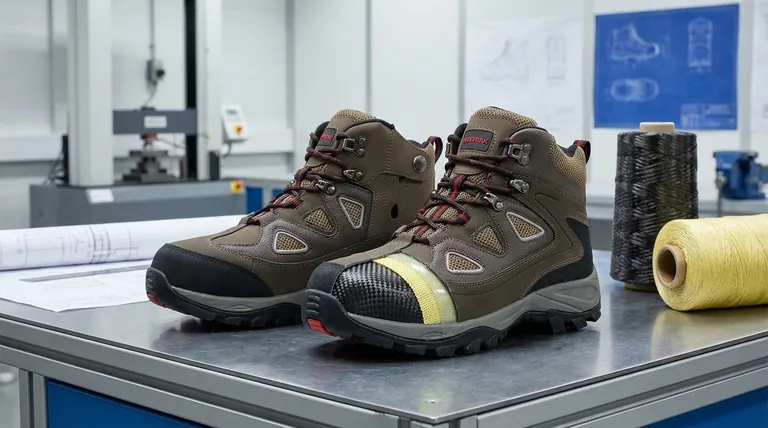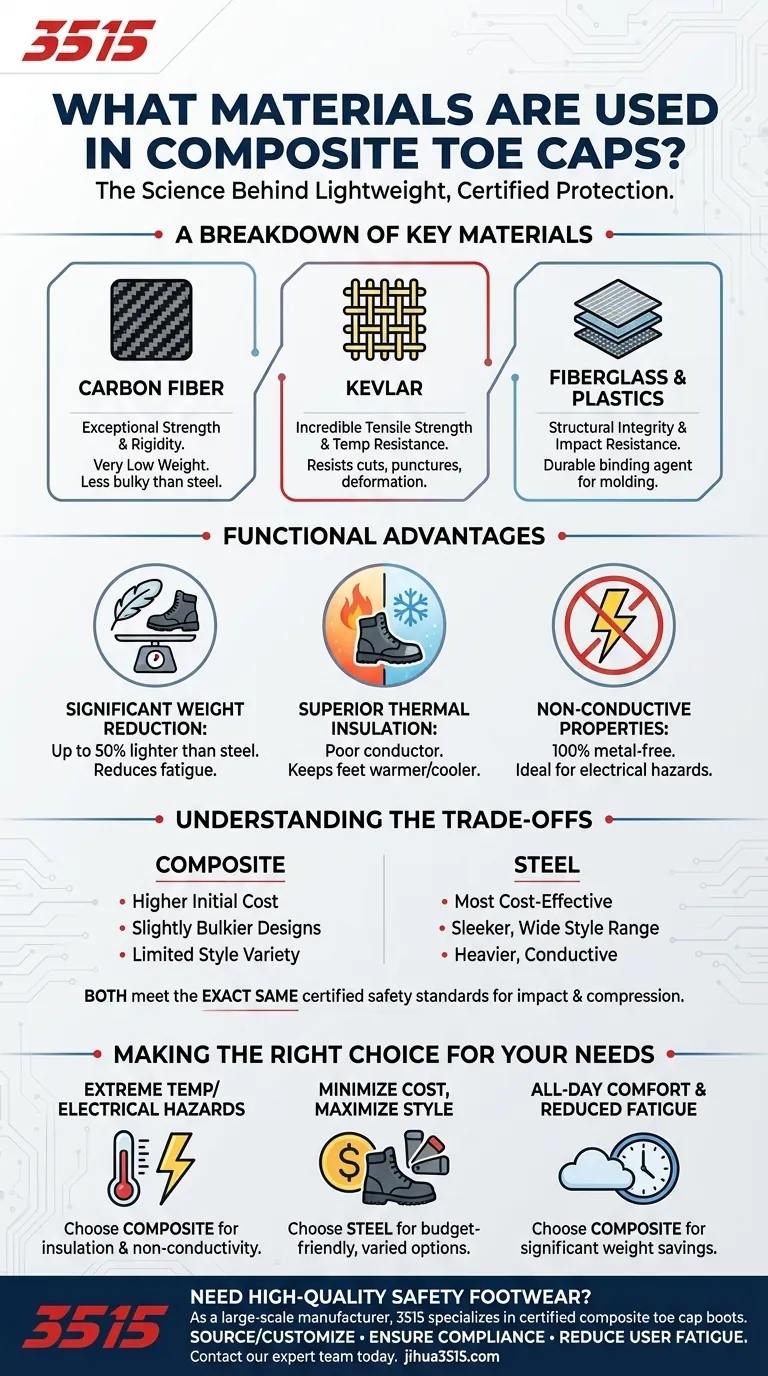Composite toe caps are made from non-metallic materials, most commonly a blend of carbon fiber, Kevlar, fiberglass, and specialized plastics. These materials are chosen for their high strength-to-weight ratio, allowing them to provide certified impact and compression protection without the weight or conductivity of traditional steel.
The core purpose of using composite materials is to achieve the same safety standards as steel while offering significant advantages in weight reduction, thermal insulation, and electrical resistance, making them ideal for specific work environments and user comfort.

A Breakdown of Key Materials
Composite toe caps are not made from a single substance but are a blend of advanced polymers and fibers. Each component contributes specific properties to the final product.
Carbon Fiber
Carbon fiber is a primary ingredient known for its exceptional strength and rigidity relative to its very low weight. This allows for a protective cap that is strong yet significantly less bulky than a steel equivalent.
Kevlar
Kevlar is a synthetic fiber renowned for its incredible tensile strength and temperature resistance. Its inclusion helps the toe cap resist cuts, punctures, and deformation under stress.
Fiberglass and Plastics
Fiberglass provides structural integrity and impact resistance at a reasonable cost. It is often combined with specialized plastics that act as a binding agent, creating the final molded shape of the toe cap and enhancing its overall durability.
The Functional Advantages of Composite Materials
The choice of these non-metallic materials directly translates into functional benefits that distinguish composite toe caps from their steel counterparts.
Significant Weight Reduction
Composite materials are substantially lighter than steel. This can reduce the overall weight of a safety boot by up to 50%, leading to less fatigue for individuals who spend long hours on their feet.
Superior Thermal Insulation
Unlike steel, composites are poor conductors of heat and cold. This means they keep feet warmer in cold environments and cooler in hot ones, providing a major comfort advantage in extreme temperatures.
Non-Conductive Properties
Being entirely metal-free is a critical safety feature. Composite toe caps do not conduct electricity, making them the superior choice for electricians and others working in high-voltage environments. They also won't set off metal detectors.
Understanding the Trade-offs
While composite toe caps offer advanced features, they are not the default choice for every situation. It is essential to weigh their benefits against their limitations.
Cost and Initial Investment
The advanced materials and manufacturing process make composite toe footwear more expensive than most steel-toed options. Steel remains the most cost-effective choice for basic protection.
Bulk and Style
Although lighter, some composite cap designs can appear slightly bulkier than the sleekest steel-toed boots to achieve the same impact rating. As a result, steel-toed footwear often comes in a wider variety of styles and designs.
The Safety Standard
It is critical to understand that both composite and steel toe caps that are properly certified meet the exact same safety standards for impact and compression. One is not inherently "safer" than the other in terms of meeting these foundational requirements.
Making the Right Choice for Your Needs
Your decision should be based on your specific work environment, budget, and comfort priorities.
- If your primary focus is working in extreme temperatures or around electrical hazards: Composite is the clear choice due to its non-conductive and insulating properties.
- If your primary focus is minimizing cost and maximizing style options: Steel remains a reliable and budget-friendly solution with a vast market selection.
- If your primary focus is all-day comfort and reducing leg fatigue: The significant weight savings of a composite toe cap make it the ideal investment.
Ultimately, choosing the right material is about matching the footwear's features to the demands of your job.
Summary Table:
| Material | Key Property | Primary Benefit |
|---|---|---|
| Carbon Fiber | High Strength, Rigidity | Maximum protection with minimal weight |
| Kevlar | High Tensile Strength, Temperature Resistance | Resists cuts, punctures, and heat |
| Fiberglass & Plastics | Impact Resistance, Structural Integrity | Durable and cost-effective molding |
Need High-Quality Safety Footwear with Composite Toe Caps?
As a large-scale manufacturer, 3515 produces a comprehensive range of certified safety footwear for distributors, brand owners, and bulk clients. We specialize in crafting boots with composite toe caps that offer superior protection, comfort, and compliance for your market.
We can help you:
- Source or Customize a wide variety of lightweight, non-conductive safety boots.
- Ensure Compliance with all relevant safety standards (e.g., ASTM, CE).
- Reduce User Fatigue with ergonomic designs built for long-term wear.
Let's discuss your specific needs. Contact our expert team today to explore our production capabilities and find the perfect safety solution for your customers.
Visual Guide

Related Products
- Safety Footwear Wholesale Manufacturer for Custom OEM/ODM Production
- Wholesale Customizable Safety Boots Durable & Protective Footwear Manufacturing
- Wholesale Premium Waterproof Nubuck Safety Shoes Boots
- Advanced KPU Athletic Safety Shoe with Steel Toe Cap Anti-Slip Rotary Lacing System
- Premium Suede Sport Safety Shoes for Wholesale & Bulk Orders
People Also Ask
- What do heavy duty boots do? Protect Your Feet in Demanding Work Environments
- What are the differences between steel toe, composite toe, and alloy toe Wellington boots? Choose the Right Safety Toe for Your Job
- Is safety-toe as good as steel toe? Choose the Right Protection for Your Job
- Is it normal to wear shoes in the house? A Guide to Hygiene, Comfort & Culture
- How do safety shoes contribute to cost savings for companies? A Strategic Investment in Risk and Cost Management



















